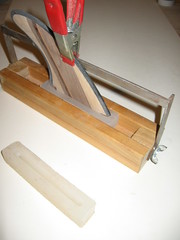First I cut the patterns in wood and paint them with a couple layers of latex paint. Futures are really easy - 1/4" thick, 4 1/2" long, 3/4' & 1/2" tall. Sand a slight taper in the the front to fit in the box, then cut the notches.

Next, I use superglue to attach the pattern (bottom up) to a base and build a box around it, leaving a 3/8" gap on all sides. A 1" deep box works fine with any size base. (You'll notice I switched to photos of LokBox molds - my Futures are tied up right now, but same process.)
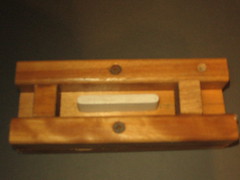
Once the mold box is set up I give the pattern and inside of the box a good coat of PVA mold release. Butcher's wax works too. Once the mold release is dry (30 sec with a hair dryer) I use 100% silicone in a caulk gun to fill the void around the pattern. Pick a starting point in the gap and circle around the pattern, pumping the silicone in without lifting the tip of the tube from the fill. Let the silicone rise to just above the mold box level and fill in the dry strip on top of the pattern last. The idea is to not make any bubbles against the pattern facets. Squeegee the excess silicone flush with the top of the mold box. It is easier but more expensive to use castable RTV rubber for this step.

Let the mold sit for 24-36 hours before trying to remove the pattern. If you remove the pattern before the center of the silicone gels, you could warp the mold, and the resulting casting will be warped. Sometimes the mold will peel right off of the pattern and out of the box. Sometimes the box has to be taken apart - that's why I only put a couple screws in it, and the end plugs are just pressure-fit. Also why the pattern is super glued to the base - easy to 'snap' off and salvage if there is a problem. Here's a shot of the silicone mold removed cleanly from the pattern.
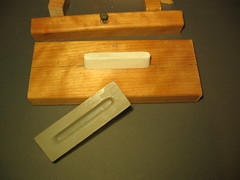
Once you've got the molds, the casting jig is easy to make. It is basically an elongated mold box (for casting two molds at once) with permanent end blocks and a swinging arm. I build mine out of 3/4" wood, and the arm out of 1/2" bar stock from Home Depot. If you don't weld, the arm can be made from wood, plastic etc. as long as it is rigid and won't flex in the center of the span.
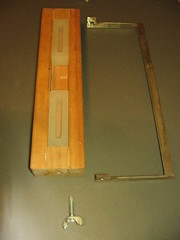
A closer shot - just a threaded insert in both ends of the jig and a wingnut bolt to fit . Notice that the pivot is not centered on the mold groove in the jig. That is because the cant adjustment arm is not touching the center of the fin, but an outside plane of the fin. In other words, off-set the pivot point 1/8" from center, and use a cant template to double check your angles. Once it's set, you can make index marks on the jig, or use stop pins.
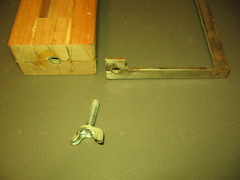
Now, when I cast the base, I'm really just casting filler for the existing base on my wood fins. I keep as much of the existing fin on as possible. I only really cast about 1/8" or less of epoxy (w/ milled glass fiber) around the existing wood base, setting the cant, and making the fit for the fin box. So, adjust the cant on the jig and tighten down the arm. Dry fit your fins in the mold, and make sure they're pointing in the right direction relative to the bases. Mask the fins with tape from the top of the mold to 3/4" up. Fill your molds about 3/4 full with resin/pigment/milled fiber mix. Put your fins in to the molds, and allow the resin to overflow slightly. DO NOT clean up all of the overflow. As the resin sets, it will shrink, and the overflow will compensate for the shrinkage in the base. Any excess can be trimmed and sanded after the base is removed.

After casting a few, you get a pretty good idea of how much resin is just enough, and the castings come out pretty clean with little finishing to be done. If your pattern had fit perfectly in your fin box, the cast base should fit the same. Here's a few measurements of the components:
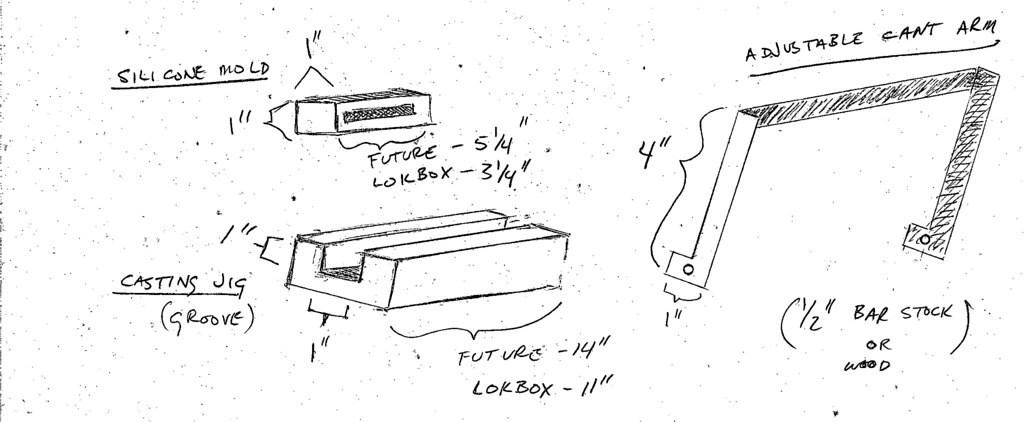
There are variations that I've come up with since making the first casting jigs, but they work so well and are not going to be retired anytime soon . . .
Feel free to use what I've got here and let me know if you've got any questions. Good Luck!
